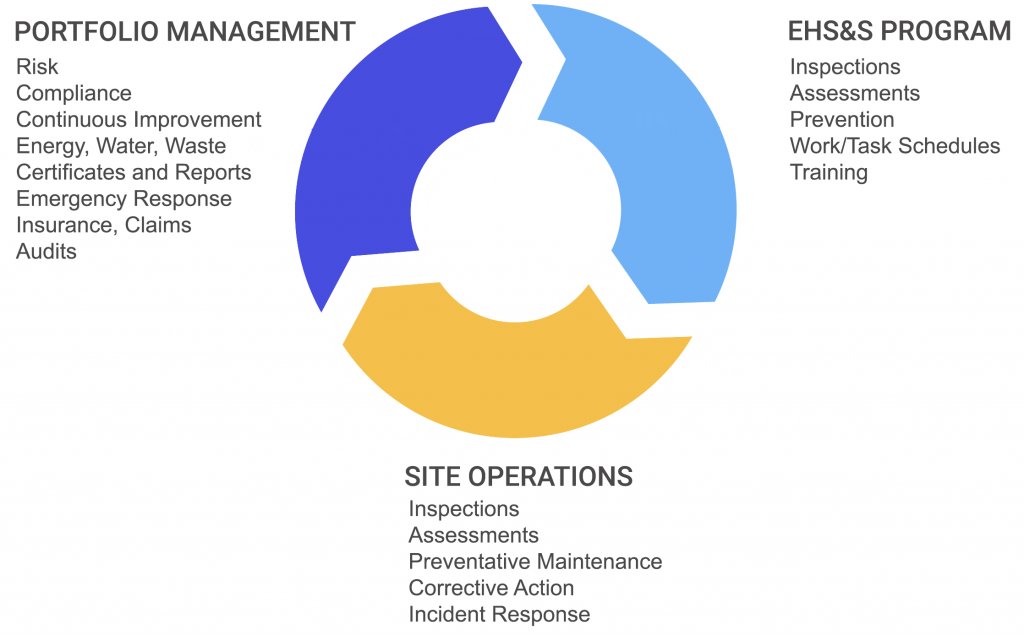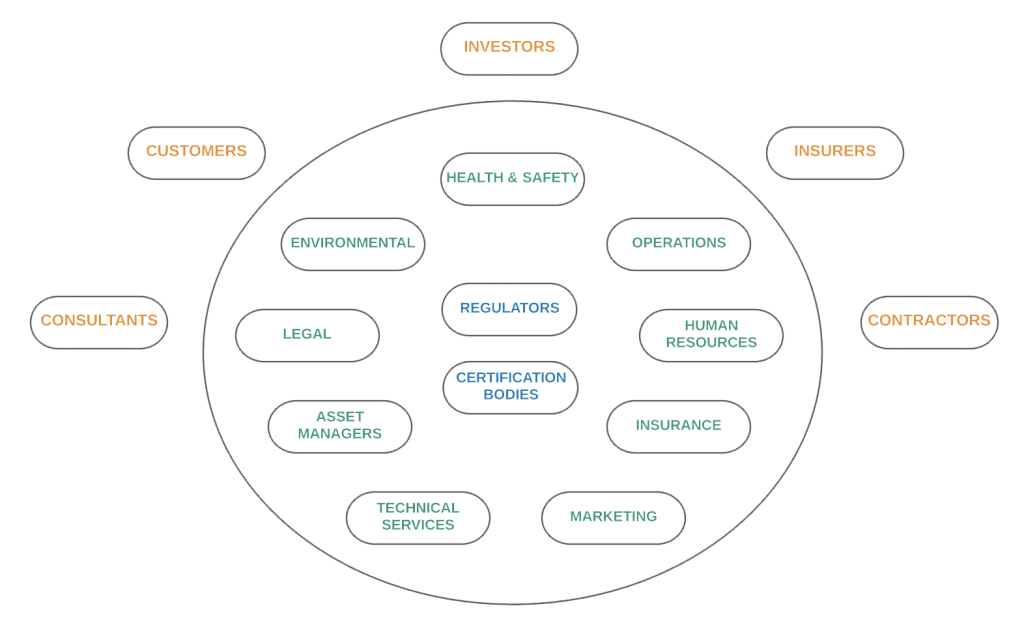EHS Management
Throughout the industrial age there were numerous accounts of workplace injuries, fatalities and environmental pollution. Initially these incidents were seen as an unfortunate cost of doing business – the price of progress. However, after many decades of piecemeal reform, government agencies were established and tasked with protecting the workforce and the environment. Out of this regulated approach the discipline of EHS (environment, health and safety) management took shape.
What is EHS Management?
Environment, Health and Safety (EHS) management is a discipline focussed on protecting the environment and people from harm while creating safe working and living environments. The environmental component of EHS is about managing the use and release of harmful substances. The health component protects employees, customers and the community from exposure to hazardous substances such as chemicals and asbestos. Finally, the safety component includes procedures designed to keep employees safe in the workplace.
As a management focus, EHS has grown in stature. No longer is the conversation purely about regulatory compliance and remediation.The EHS conversation today is about end to end, integrated business processes; it is about operational efficiency and continuous improvement; it has become a central element of sustainable, resilient corporate strategy and has attracted the attention of the institutional investment community.
The image below illustrates important elements of EHS management programs. Operations teams conduct routine inspections, assessments and preventative activities, feeding valuable insights back to management teams. These insights, along with evolving regulatory requirements, are incorporated back into EHS program elements. Continuous improvement is a critical component of safety, risk reduction and operational efficiency.

Why Manage EHS?
The simple answer is that we manage EHS because we have a regulatory requirement to do so in most organizations. Failing to comply results in financial penalties from regulatory authorities. Fortunately, the EHS conversation is about far more than simply cost and compliance.
Studies show that EHS management has a positive return on investment (ROI) and is a strong indicator of sustainably managed companies. In this 2020 survey, 74% of senior finance leaders report that investors increasingly use non-financial information in decision making. No longer will CFOs be measured solely on financial metrics, such as earnings per share, dividend yield and return on capital. They are also measured on quantifiable EHS and ESG metrics that benefit all stakeholders.
This stakeholder consideration has important links to any discussion about the ROI of managing safety and compliance. The answer to the question of why EHS management is important to investors is almost certainly understood by examining the ROI of EHS.

The Return on Investment (ROI) of EHS
EHS management impacts every employee in your organization and extends to several external stakeholders. Consequently, the cost of managing EHS and integrating health and safety into the culture of an organization is significant. In many industries, including real estate, health and safety must be embedded in the work procedures of almost every front-line worker; this is the direct cost of managing EHS in every organization. This, along with workers compensation and liability insurance, is the direct cost of compliance and safety in the workplace.
While the direct costs of managing compliance are material, the cost of non-compliance with EHS regulations is more significant. Fines, healthcare costs, lost time at work, environmental remediation costs, and insurance claims and premiums can add significant, avoidable costs. To put this in context, The National Safety Council reported that workplace injuries cost the US economy a staggering 171 billion dollars in 2019 and estimates the cost of each workplace fatality at roughly 1.2 million dollars.
Faced with statistics like this it is easy to understand how quickly the cost of non-compliance exceeds the cost of managing compliance. It is easy to understand how lost time at work impacts business continuity, productivity, quality and worker morale. It is easy to connect patterns of workplace disruption to increased staff turnover and ultimately to a negative brand perception.
Contrast a non-compliance mindset with the alternative – organizations who publicly commit to worker, environmental and community safety. Through this lens we quickly see why investors value EHS performance. Leadership commitment to worker health and safety translates into an engaged workforce who feel valued. Valued employees are more loyal, more likely to remain with their company and more likely to engage and shape a positive culture. Reduced staff turnover in turn reduces training costs, hiring costs and the impact on business continuity.
In summary, a positive compliance mindset with executive leadership support and an engaged workforce creates a more resilient organization while reducing operating costs. This translates into organizations that are more likely to survive competitive and changing market conditions. These are the companies most likely to attract and retain top talent. These are companies with more organizational bandwidth to focus on growth. These are attributes of a strong brand.
This is why investors recognize the importance of effective EHS management.
What are the Benefits of EHS Management?
EHS management programs provide several qualitative and quantitative benefits to an organization. Ultimately, EHS management is good for business, but here are some of the reported benefits:
- Project a corporate commitment to sustainable management and sound governance.
- Align EHS management strategy with operational tactics.
- Minimize operating and legal costs.
- Mitigate business and operational risks.
- Attract investment capital.
- Attract and retain top talent.
What are the Challenges of Managing Risk, Safety and Compliance?
EHS management is distinctly challenging in the real estate industry for the following reasons:
- The complexity of coordinating communication, information and workflow across distributed teams of employees and service providers is possibly the biggest challenge of all. The people managing our buildings are extremely busy and responsible for tenant satisfaction, maintenance, safety and so much more. Success hinges on our ability to engage and connect this network of people with actionable information and minimal administration.
- The transient nature of the teams who are operationally responsible for managing our assets and the extensive amount of information required to do so successfully, requires a thoughtful combination of training materials and management audits to promote adoption, engagement and compliance with EHS programs and procedures.
- The geographically distributed nature of the assets (sites/buildings) makes it hard to verify that every building is safe and compliant at all times.
- The unique and changing characteristics of individual assets requires EHS procedures that are both comprehensive and flexible.
Regulations set the minimum standard for meeting local, state, provincial and federal health and safety requirements. However, the challenge of EHS management is to integrate these regulations into effective operating policies and procedures.
Certifications in Risk and Safety Management?
There are a number of organizations who offer industry-recognized certifications in risk and safety management. Many of these programs are internationally recognized.
Risk and Safety Certifications in Canada
- BCRSP from the Board of Canadian Registered Safety Professionals.
- Certified Health and Safety Consultant certification (CHSC) from the Canadian Society of Safety Engineering (CSSE).
- Canadian Risk Management (CRM) from The Risk Management Society (RIMS).
- Environmental Professional designation (EP) from ECO Canada.
Risk and Safety Certifications in the United States
- Certified Safety Professional (CSP) from the Board of Certified Safety Professionals (BCSP).
- Certified Safety and Health Manager (CSHM) from the Institute of Hazardous Materials Management (IHMM).
- IOSH Level 3 Certificate from the Institute of Occupational Safety and Health (IOSH).
- OSHA 30-Hour Qualification (not a certification) from the US Department of Labor.
- Qualified Environmental Professional (QEP) from the Institute of Professional Environmental Practice (IPEP)
- Associate Environmental Professional (AEP) from the National Registry of Environmental Professionals (NREP)
- Registered Environmental Manager (REM) from the National Registry of Environmental Professionals (NREP).
- Registered Environmental Professional (REP) from the National Registry of Environmental Professionals (NREP).
- Certified Hazardous Materials Manager (CHMM) from the Institute of Hazardous Materials Management (IHMM).
- Certified Professional Environmental Auditor (CPEA) from the Board for Global EHS Credentialing (BGC).
- EMS Auditor or Lead Auditor from CQI/IRCA.
ISO Standards and Auditor Certifications
Refer to our article on ISO standards for more links to training and certifications related to EHS and ESG.